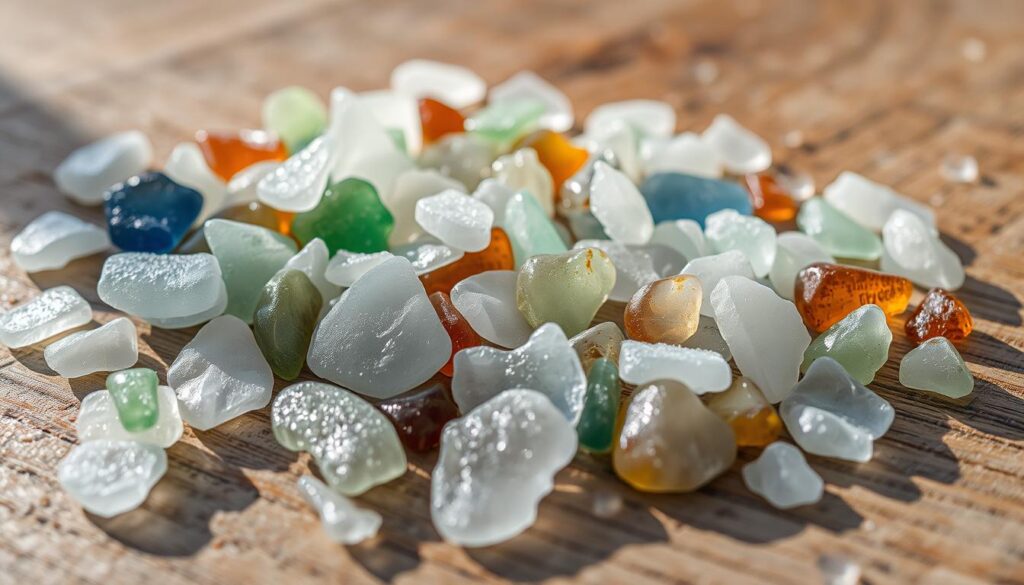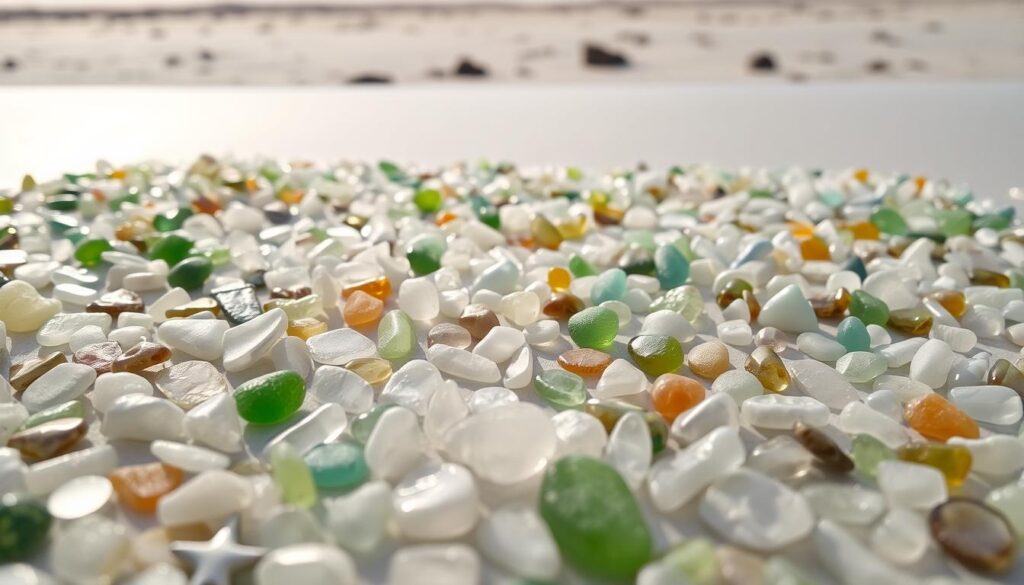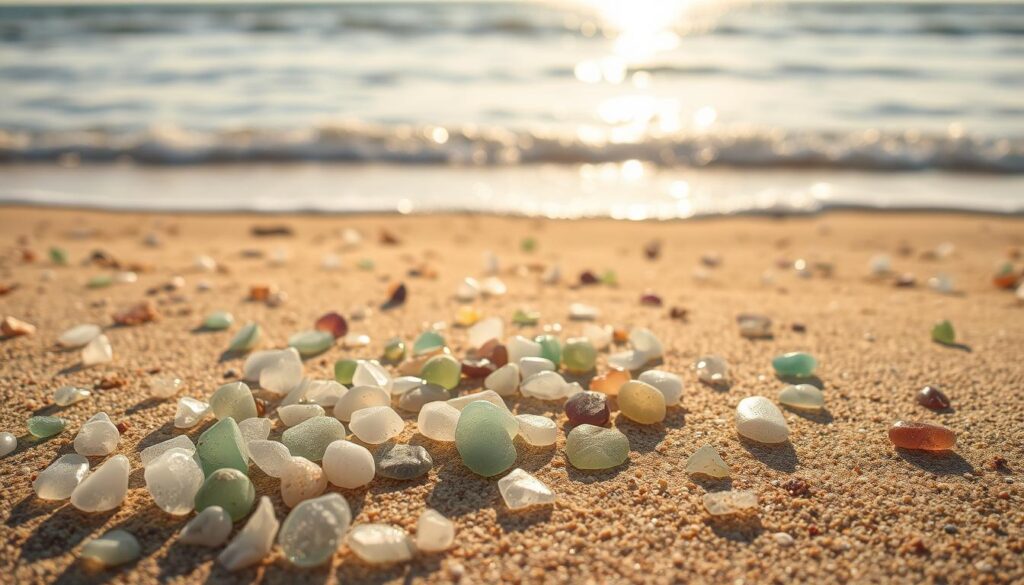Sea glass, a treasure formed by the relentless tumbling of ocean waves, sand, and time, washes up on beaches in a kaleidoscope of colors and shapes, each piece bearing its own unique history.
As you stroll along the beach, the thrill of beachcombing for these frosted treasures is a sensory experience like no other. The smooth, weathered glass pieces are not only beautiful but also tell a story of their transformation over the years.
For both casual collectors and serious enthusiasts, the joy of collecting sea glass lies not only in the hunt but also in the art of preserving these finds. Proper techniques for handling your treasures are essential to maintaining their beauty and integrity.
The Magic of Sea Glass Collecting
The allure of sea glass collecting lies in its unique blend of treasure hunt and historical connection. As you comb the beach, you’re not just searching for beautiful pieces of glass; you’re uncovering fragments of history that have been smoothed by the relentless action of the sea.
Sea glass forms through decades of natural tumbling in ocean waves, creating smooth, frosted pieces with unique character. This process not only changes the glass’s appearance but also gives it a distinct texture that’s both pleasing to touch and visually appealing.
What Makes Sea Glass Special
The chemical process of hydration is what gives sea glass its distinctive frosted appearance and texture. Over time, the glass reacts with the water, leading to a gradual dulling of its surface. This transformation is what makes sea glass so prized by collectors.
The ocean’s constant motion ensures that something new is always being washed in, making every beach visit a potential discovery. For sea glass enthusiasts, this means that the thrill of the hunt is always present, as they search for that rare piece to add to their collection.
Popular Colors and Their Rarity
The most common sea glass colors are clear, green, and brown, which derive from various types of glass products like beer bottles and medicine bottles. However, rare finds like red, orange, yellow, and purple sea glass are highly sought after by collectors due to their scarcity.
The color of sea glass can help identify its origin and approximate age. For instance, certain colors were more prevalent during specific periods, making them valuable indicators of the glass’s history. As a result, collectors and artists often use the color and rarity to determine the value of their sea glass pieces.
Essential Beach Trip Preparation
The key to a fruitful sea glass collecting adventure lies in your preparation and timing. Proper preparation involves gathering the right gear and understanding the best times to visit the beach.
Best Gear for Sea Glass Hunting

For a successful sea glass hunting expedition, you’ll need the right gear. This includes comfortable footwear, collection bags, and sun protection. Bringing small tools like a rake or scoop can also be helpful for sifting through pebbles and sand.
Timing Your Beach Visit for Maximum Finds
Consulting a local tide chart is crucial for timing your beach visit. Low time generally offers the best opportunity for finding exposed sea glass. Weather conditions also play a significant role, with post-storm periods often yielding the best finds due to churned-up shorelines.
Identifying Quality Sea Glass Pieces
When searching for sea glass, it’s essential to know what makes a piece valuable. Quality is characterized by smooth edges, a frosted appearance, and the absence of sharp corners.
Characteristics of Well-Tumbled Sea Glass
Well-tumbled pieces have undergone significant transformation due to environmental factors. Key characteristics include a frosted surface and smooth edges. When you rub a piece between your thumb and middle finger, it should feel smooth and rounded.
Distinguishing Sea Glass from Regular Beach Glass
Not all beach glass is sea glass. True sea glass comes from oceans and seas. The appearance and texture can differ significantly. Sea glass tends to have a more frosted appearance and smoother edges. You can also look for small pits and C-shaped marks.
- Check for a frosted surface and smooth edges
- Examine the piece for small pits and C-shaped marks
- Rub the glass between your fingers to check for sharp edges
- Consider the color saturation and unique markings

How to Clean, Sort, and Store Sea Glass After a Beach Trip
To maintain the quality and appearance of your sea glass, thorough cleaning and sorting are necessary after your beach trip. This process not only enhances the beauty of your collection but also helps in identifying the unique pieces you’ve gathered.
Initial Rinsing and Preparation
The first step in cleaning your sea glass is to rinse it in plain water to remove any loose sand and salt. This initial rinse is crucial as it prevents scratching during the deeper cleaning process.
Deep Cleaning Methods
For a more thorough clean, fill a bowl or plastic basin with lukewarm water and add a mild soap or detergent. Froth it up gently and then carefully place your sea glass into the soapy water, avoiding any scratching. Gently rub each piece with your thumbs to loosen any grit, and let it soak for a couple of hours. After soaking, transfer the sea glass to a sieve or colander and rinse it under running water or in a fresh bowl of clear water.
Dealing with Stubborn Dirt and Stains
For sea glass with stubborn dirt or stains, consider using an ultrasonic cleaner or a soft-bristled brush to gently remove embedded dirt. Be cautious with colored glass and avoid harsh chemicals like bleach, which can damage the glass or alter its appearance. Natural cleaning agents such as lavender oil can be effective in removing stubborn marks while leaving a pleasant scent.
After cleaning, pat your sea glass dry with kitchen paper or a soft, lint-free cloth to prevent water spots. Patience is key during this process to maintain the integrity of each piece.
| Cleaning Method | Description | Best For |
|---|---|---|
| Initial Rinsing | Rinsing in plain water | Removing loose sand and salt |
| Soapy Water Soak | Soaking in lukewarm soapy water | Loosening embedded dirt and grit |
| Ultrasonic Cleaner | Using an ultrasonic cleaner | Deeply embedded dirt in small pits |
Effective Sorting Techniques
Organizing your sea glass collection can be a therapeutic process with the right approach. To start, you need to create an environment that makes sorting efficient and enjoyable.
Creating a Comfortable Sorting Surface
Using a white quilt batting as a sorting surface can significantly enhance your experience. The bright white color provides an ideal background for identifying the colors of the glass pieces. Additionally, the soft texture of the batting prevents scratching and makes it easier to handle the glass. You can simply grab both sides of the batting and funnel the sorted glass back into its container when you’re done.

Categorizing by Color, Size, and Quality
Categorizing your sea glass by color, size, and quality helps in organizing your collection effectively. You can start by separating the pieces into broad categories based on their color. Then, within each color group, you can further sort by size and quality. This system makes it easier to find specific pieces when working on art projects or displaying your collection.
Separating Usable from Display Pieces
It’s essential to differentiate between pieces that are suitable for crafting and those that are better suited for display. Usable pieces should be of a certain quality and size that makes them suitable for jewelry making, mosaics, or other crafts. Display pieces, on the other hand, might be rare, exceptionally beautiful, or have unique characteristics that make them valuable as standalone items.
| Sorting Criteria | Description | Benefits |
|---|---|---|
| Color | Sorting by color helps in creating a visually pleasing collection. | Easier to find matching pieces for art projects. |
| Size | Separating by size aids in projects requiring specific dimensions. | Streamlines the process of selecting pieces for crafts. |
| Quality | Categorizing by quality helps distinguish between usable and display pieces. | Ensures that the best pieces are reserved for display or special projects. |
Enhancing Your Sea Glass Collection
The art of enhancing sea glass involves more than just displaying it; it’s about bringing out its inherent colors and translucency. One effective way to achieve this is by applying a small amount of oil to your sea glass pieces.
Using Oil to Bring Out Colors
Applying a bit of oil can temporarily enhance the color and translucency of sea glass for photography or display. Various types of oils work well, including baby oil, mineral oil, and coconut oil, each with varying effects on different colors of glass.
To apply oil sparingly and avoid an overly greasy appearance, use a cotton ball to dab a small amount onto your finger and gently rub it onto the glass. This technique allows you to control the amount of oil used.
When to Preserve the Natural Frosted Look
While oil can enhance the appearance of sea glass, some collectors prefer to preserve the natural frosted look as evidence of the glass‘s journey. The frosted appearance is a result of years of tumbling in the ocean, and it adds character to the sea glass.
For those who prefer the natural look, it’s essential to note that oil treatments are temporary and will need to be reapplied periodically if the enhanced look is desired. If you decide to return to the natural frosted appearance, simply wash the sea glass with soap and water to remove the oil.
For more information on working with glass, you can visit this resource on creating or renovating stained glass windows.
Creative Storage Solutions
The way you store your sea glass can greatly impact your ability to enjoy and utilize it. Whether you’re an artist using sea glass in your crafts or a collector displaying your finds, having a practical and efficient storage system is essential.
Practical Containers for Artists and Crafters
For artists and crafters, storage containers need to be both accessible and protective. Shallow drawers or divided containers are ideal for organizing different sizes and colors of sea glass, making it easier to find the right piece for your project. You can also use fabric pouches or small bags to store and transport your sea glass.
Display Options for Collectors
Collectors often want to showcase their sea glass in an attractive way. While mason jars or vases may look beautiful, they can be impractical for accessing specific pieces. Instead, consider using shadow boxes or custom frames to display your favorite pieces. You can also create themed displays based on color, size, or origin to enhance the visual appeal of your collection.
Organizing for Easy Access
To maintain efficiency, it’s crucial to organize your sea glass in a way that allows for easy access. Using baskets or drawers with separate compartments can help you quickly find the piece you need. Labeling your storage containers can also help you track the origin of your sea glass, especially if you collect from multiple beaches.
Conclusion
The joy of sea glass collecting extends far beyond the beach trip itself. Properly cleaning, sorting, and storing your sea glass pieces not only enhances your enjoyment but also preserves their beauty for years to come.
By adopting responsible beachcombing practices, such as returning “young” glass to the water to continue tumbling, you honor the natural processes that shape these treasures. A well-organized collection makes it easier to appreciate the variety and beauty of your finds.
Whether you’re a casual collector or a serious artist, these techniques will help you develop a personal system that works best for your collection goals, ensuring that your sea glass remains a source of joy for time to come.
